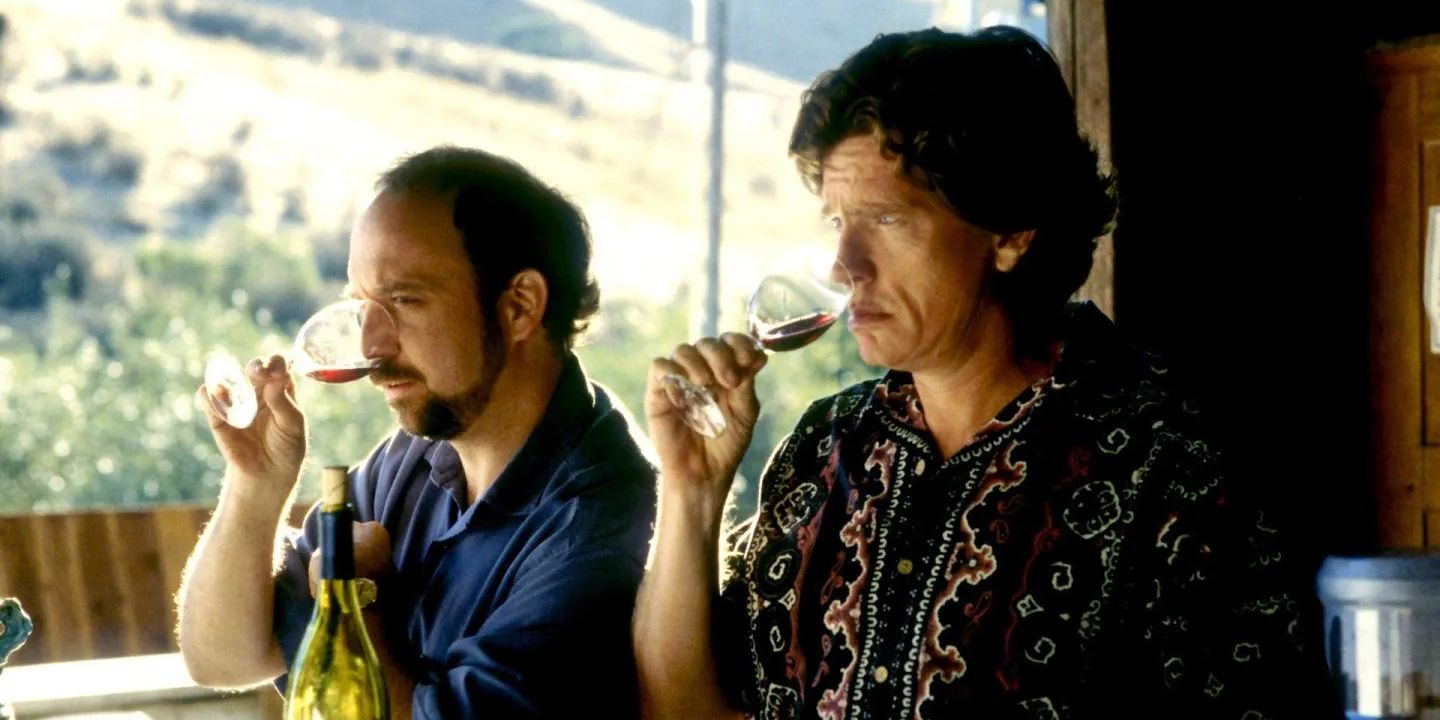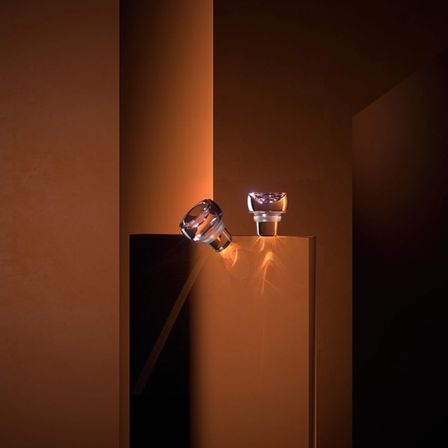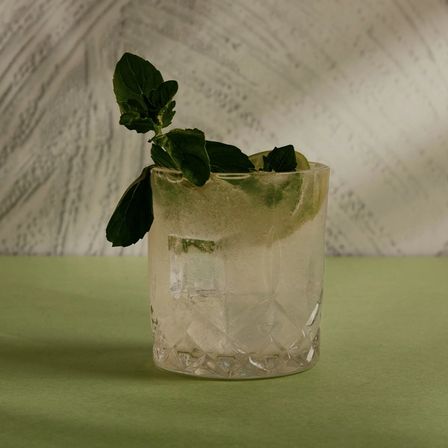- Opinion
Cinematically drunk: The most revealing on-screen wine cameos
From Sideways’ Pinot obsession to Succession’s Prosecco put-downs, wine on screen reveals as much about the characters drinking it as the bottles themselves.
- Words By Lisse Garnett
The Sumerians thought wine facilitated communion with the Gods. Filmic consumption is slightly more prosaic — but offers enlightenment all the same. We care what our favourite characters on the big screen drink, and sometimes we drink with them. Californian Pinot sales more than doubled after the film Sideways was released in 2004. Merlot took a small dive.
The first Vitis grapes to grace Californian soil were planted by Franciscan missionaries for communion wine. Then came the Gold Rush, complete with thirsty prospectors, followed by Prohibition, which laid the groundwork for organised crime. Pinot was first planted in the Napa Valley at Inglenook in the mid-1880s; the estate is now aptly owned by film director Francis Ford Coppola, who paid for it with the proceeds of Godfather I and II. Talk about poetic.
Pinot Noir is known as the heartbreak grape. Like Miles in Sideways — the needy, grouchy, failing divorcee at the centre of the tale — it is thin-skinned and temperamental and requires constant care and attention. Pinot plays a lead role in pleasuring the characters in the film. Discernible labels reveal Whitcraft 2001, Sea Smoke Botella, and Kistler Sonoma Coast Pinot Noir — all now highly sought-after, impossible to find, and much more expensive than they were due to their cameos.
Wine is the drink of pissheads and aristos alike; Miles has a foot in both camps. He is an arbiter of tastes and a bit of a twat; his pretentious vinous posturing would no doubt induce fury in real life, yet time and time again, people ask this disgruntled intellectual for advice. He is reluctant to respond to Maya, his love interest, because she’s a lowly waitress, and his pathetic, contradictory Merlot snobbery is very telling. Merlot is a variety that brings body, a velvety texture and mellowness; Miles’ most prized bottle is a 1961 Château Cheval Blanc, a wine composed of approximately 46% Cabernet Franc and 54% ‘fucking Merlot’.
No, if anyone orders Merlot, I am leaving, I am not drinking any fucking Merlot
— Miles Raymond
Château Cheval Blanc is probably the most sought-after Cabernet Franc-based wine in the world. It is one of only four properties in the highest categorisation tier of St Emilion — the clunkily named Premier Grand Crus Classé (A). A great favourite of Jancis Robinson, Cheval Blanc 61 is reputed to be one of the greatest vintages ever made: sweet, deep, rich with black fruit and fecund humus; though the only tasting note we should go on really, is Mile’s face. I found a bottle for sale for just shy of four grand (ouch). Perhaps a case of six magnums at 55k is a better bet. Miles’s eventual enlightenment is pitch-perfectly presented through the solo consumption of his beloved Cheval Blanc from a Styrofoam cup whilst scoffing a cheeseburger as he journeys expectantly to Maya. The movie begins and ends with a knock at the door.
Miles in Sideways is part of a grand tradition of on-screen drinking and directorial winking. The things our most memorable characters drink tell us precisely who they are — and even who they are going to be.Stolen 1986 Château Pichon Longueville in The Sopranos. Imagined beer supped to defy the ‘combine’ in One Flew Over the Cuckoo's Nest. Fatalistic drops of red wine spilt from a Russian Orthodox wedding goblet in The Deer Hunter. Expensive Chardonnay ‘not’ drunk by x-ray-thin yuppies who can no longer take solids in American Psycho. Dying of Aids with Tom Hanks and Dom Perignon in Philadelphia. Fêted Etna Wines lauded for ‘a bunch of volcanic minerals’ in White Lotus.
Look at him over there, fizzing away like a bottle of cheap Prosecco…
— Lady Caroline Collingwood
Succession's brilliant characterisation of Britain through booze and food slices right through our collective psyches. Lady Caroline Collingwood is the bloodless, lean, acid-etched British mother of the Roy children. Her larder is empty, and her pheasant is full of shot: ‘Mind how you go, or you’ll crack a tooth.’ Her arch disdain for emotional warmth is perfectly conveyed through her empty larder, her leftover ‘stubbie’ bread, her forbidden cheese, and her perfunctory drinking. She is the polar opposite of Marcia, her sensual Lebanese replacement. She compares her husband-to-be to a bottle of cheap Prosecco, a perfect characterisation of a man she knows is turned on by her lucre. Prosecco at its finest is a beautiful drink, but the cheap tank-made sugary stuff is judiciously conjured here.
His cellar is all New World and it doesn’t suit me.
— Marcia Roy
The Roy children in Succession are stateless refugees for whom a Scotch egg is a giant arancini. Connor Roy, the titular first-born, is a fuckwitted fool given to decanting Romanée Conti in a Nutri-bullet. An outsider in life and at his own wedding, he drinks Merlot-rich Château Haut-Brion alone, the only First Growth that lies out with the Medoc.
Screw top German Spätburgunder (aka Pinot Noir) is brilliantly cast as the biodynamic effluent created by Shiv and Tom at their newly acquired, achingly fashionable vineyard. The wine is a perfect manifestation of arriviste parvenu posturing by Tom Wambsgans. It reveals just how much the man wants to climb; biodynamic farming shuns chemicals and follows the lunar calendar; it is the ultimate rich trend-setting box tick. The inaugural tasting scene is priceless. Declaring it the first bottle from ‘our vineyard’, Tom’s disappointment is palpable, ‘Oh. Screw top’, ‘so it’s biodynamic’. ‘Has quite a funk to it’..’ you kind of have to meet it halfway, right?’ Shiv chimes in with ‘earthy’ and ’Germanic’, Tom says ‘there's lots to unpack…it’s not floral, it’s not sugary or vegetal, it’s quite… agricultural’. And then, finally, deflated: ‘It’s not very nice, the wine, is it Shiv?’
I envisage a natural wine par excellence as the main protagonist here, a natty, sheep daggy funk fest of fecundity that probably has Brett — a yeast that produces acetic acid and has a horsey aroma. Loads of people love it. Musar is famous for it, but cast in this way, I read a desperate attempt by Tom to ride the natural trend, to cling on to something youthful and vital as he anticipates a looming prison sentence.
Elsewhere, liberal media boss Nan Pierce’s declaration on the delights of cheap wine reeks of pretentious Dayglo liberalism. ‘I got a taste for ‘hypermarché vin ordinaire when I was 19 years old... I like my wines thin and vinegary’, she lies. Not a drop is wasted in this script.
Pine Barrens is possibly the finest episode of The Sopranos ever made and is reminiscent of Beckett’s brilliant one-act play Waiting for Godot. Gangsters Chris and Paulie are sent to the vodka-necking Russian mafioso, Valery’s house by Russian gangster Slava to collect a debt. Slava drinks Grey Goose, a smooth French vodka which, like Valery’s hi-tech sound system, is a clear marker of how far these once-impoverished Russians have come. Paulie messes with Valery’s Western stereo tech, and they kill him for objecting. Only they don’t. Having taken him to the Pine Barrens for disposal, they realise he has bitten through the tape they tied him with and is very much alive. So ensues one of the finest episodes of any TV show ever, which culminates in Paulie wearing carpet shoes and eating tomato sauce sachets for dinner. Throughout the hunt, various calls back to Tony are marred by poor reception; he tries to warn them Valery is, in fact, an assassin from Spetsnaz, a special unit of the Russian Interior Ministry and has killed 16 Chechen rebels single-handed. Paulie only hears, ‘he killed 16 Czechoslovakians; the guy was an interior decorator.’
His house looked like shit
— Christopher Montisanti
Sopranos scripts are gold when it comes to characterisation through booze. Tony loves a Ruffino Chianti Ducale Ora Reserva, the brand patronised by Duca D’Aosta of the Royal House of Savoia. I spy a 2002, which is a chewy, solid, powerful wine, predominantly Sangiovese with a touch of Cabernet and Merlot and a couple of years in Botti (large barrels) made from Croatian oak. Anticipate robust tannins, blackcurrant, cedar, leather and tobacco, and a degree of over-extraction — just the way Tony likes it.
And every time he put the bottle to his mouth, he don’t suck out of it, it sucks out of him
— Chief Bromden
Sex, politics, race, redemption and social tension reach a frenzied pitch in One Flew Over the Cuckoo's Nest, starring Jack Nicolson and based on the Ken Kesey novel published in 1963. Kesey worked in the real psychiatric hospital where the film was shot, and genuine inmates participated in the filming. Nicolson plays Randall Patrick McMurphy (Mac), who fakes insanity to escape a jail sentence for statutory rape, only to discover he has walked into a horror show. Narrated by the Chief, this matchless yarn culminates with a bitter-sweet victory for the man against the machine.
The film’s denouement is fuelled by Smirnoff mixed with strawberry-flavoured codeine cough syrup and Candy and Sandy’s illicit gallon vino of the cheapest red, which McMurphy derides as ‘cheap Port’. It does the job: Billy Bibbit loses his virginity, banishing Oedipus for a time, and Big Chief Bromden ensures Murphy has the eternal last word. It’s the perfect countercultural acid trip stoner movie, set just before America’s loss of innocence courtesy of Vietnam and the assassination of JFK. And that final heady cocktail seems perfectly matched to the wider national mood at the time.
We drink because it’s what men do
— Roger Sterling
Madmen is a bacchanalian booze-fest of unmatched proportions. ‘At the Codfish Ball’ focuses on Sally’s rude transition to adulthood. Peggy and Abe decide to live in sin and hit the Harvey’s Bristol Cream, the best-selling sherry in the world at the time with a booming US export business; Megan’s mum, sick with ennui and the tedious demands of an intellectual Marxist spouse, sups Champagne and is caught by Sally giving Roger Sterling head. The same episode sees Draper order Sauternes with pudding at the Heinz pre-pitch. Closing shots show Sally slurping her Shirley Temple through a straw, her innocence lost in the ‘dirty’ city forever.
Seven Seasons of Madmen culminate in Don’s meditative enlightenment sans booze. Ninety-two episodes star an ever-changing orgiastic, era-sensitive smorgasbord of drink from the fifties to 1971, when Don comes up with that seminal Coca Cola ad. Drink is as integral to the script as advertising, as sex.
‘I’d like to buy the world a Coke’ really was the work of a man from McCann Erikson named Bill Backer, who wrote the strapline on a napkin as he boarded a flight from London. He was on a dry spell since coming up with ‘it’s the real thing’ at the time. Originally planned for a Dover shoot complete with white cliffs, the weather pushed the location to a hilltop in Rome. When the lead actress bailed, they found a replacement by scouring the streets, settling on a British governess. The ad eventually came in two and a half times over budget at 250k, screening to wide acclaim in 1971. Baker wept with happiness when he saw it saying, ‘If the world only remembers me for this commercial, I’ll have lived a pretty good life.’
All those moments will be lost in time, like tears in rain
— Roy Batty, Blade Runner, pays homage to Withnail
The tender closing scene of Withnail and I finds Withnail alone swigging 1953 Château Margaux from the bottle in the rain at London Zoo. Château Margaux is a picture-perfect iconic property in the Haut-Medoc, built in the 19th century to impose an aristocratic veneer onto already excellent wines. 1953 was a superlative, haunting, perfumed vintage. It will currently set you back around £1800. Like Withnail, Château Margaux suffered a decade of poor vintages from the late sixties into the 70s, so the ‘53 brings an apposite dollop of nostalgia, too. The original script had Withnail pour the wine into Uncle Monty’s gun, then place the barrel in his mouth and proceed to blow his brains out. Instead, Hamlet has the last word. Tears mingle with rain on Withnail's cheeks as he delivers Shakespeare’s finest lines to the wolves. He mourns the loss of Marwood, who, in the words of Danny the Dealer, has ‘let go before it’s too late’. It wasn’t too late for Marwood. It is for Withnail.
I have of late, wherefore I know not, lost all of my mirth
— Hamlet (& Withnail)
Come on in the Chablis lovely, Your new home of drinks.
Stay up to date with all the latest from House Of Decant.





